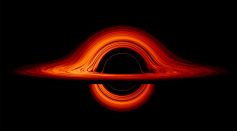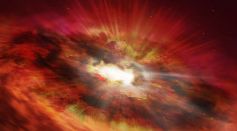Tags: Black Hole

What Did Experts Find Upon Discovering Milky Way's First Ever Black Hole? Researchers to Report Soon!

Chandra Telescope Captures Intermediate Black Holes in Star-Filled Galaxies, Explains How They Obtain Absurd Sizes

NASA Hubble Space Telescope's New Discovery Could Be the "Missing Link" to Universe's Origins?

Unicorn Star System Black Holes Are Actually Binary Stars, Study Finds

ESO VLTI Shares Stunning Thermal Image Of Supermassive Black Hole In Messier 77 Galaxy
NASA Launches IXPE Mission Atop SpaceX Falcon 9; X-Ray Initiative to Study Exploding Stars and More

NASA Telescope Sees Merger of Two Black Holes That Could Cast Doubt on Laws of Physics
Astronomers Detected Gamma Rays From Ultra-Fast Outflows, Providing Insights on the Evolution of Galaxies
Are Black Holes Scarier Than a Ghost? 5 Fun Facts About Them
Is Black Hole the Scariest Thing in the Universe? Probably, Experts Explain Deadly 'Spaghettification'
Study Says Neutron Star Collisions Produce More Heavy Elements Than Neutron Stars and Black Hole Merging
LOFAR Telescope Reveals How Volcanic Black Holes Emit Oozing Gases

Did a Black Hole Cause a Rare, Premature Supernova? Scientists Explain How It Happened
X-Ray Magnifying Glass of Chandra Gives Enhanced Resolution of Distant Black Holes, Sheds Light on Possible Black Hole System in Early Universe
How Black Holes Form: New Simulation Video Shows How Galaxies Feed Supermassive Mouths
Black Holes as Energy Sources of Advanced Civilization? Theoretical Megastructures Dyson Spheres May Catch Energy Up to 100 Million Suns
Not the Glutton That You Think: Black Holes Do Not Swallow Everything in Space
Black Holes Burp Like Babies While Eating Nearby Stars, Gas; Does It Affect Their Sizes?
Scientists Identify Bending Lights Around Supermassive Black Hole; Study Accidentally Proves Einstein's Theory of General Relativity

Light Behind Black Hole: Never-Before-Seen Phenomenon for Astronomers
Most Popular

Why Stars Twinkle: Flickering Explained by Atmospheric Turbulence and Light Distortion

The Role of Materials Science in Engineering: How Modern Engineering Materials Drive Innovation

Tornadoes vs. Waterspouts vs. Dust Devils: Key Differences and Vortex Types Explained

Climate Adaptation Strategies Explained: How Societies Respond to Climate Change





